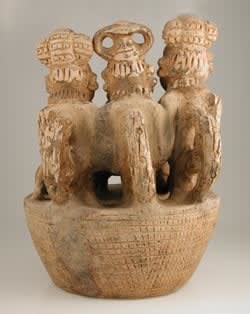Igbo Terracotta Sculpture of a Family Group, 20th Century CE
Terracotta
10.5 x 12.75
PF.4973
Further images
The Igbo of modern Nigeria are in many ways the counterpart of the Yoruba. They too are a large people consisting of many tribes inhabiting the territory from the Delta...
The Igbo of modern Nigeria are in many ways the counterpart of the Yoruba. They too are a large people consisting of many tribes inhabiting the territory from the Delta to the Cross River in the east.
Most of the Igbo have cultivated yam as one of their most important crops, and it has certainly been a focal point of their annual harvest thanksgiving feasts. The yams are staked on a tall scaffold, and mask dances are held. In the northern districts white female masks are brought out. In the southern districts clay figures are often molded as protectors of the yam fruit. This makes it highly likely that this sculpture was created by a member of the Kwale-Igbo of this region.
In this sculpture, an Igbo husband, his three wives and children bring sacrifices (including what appears to be a dog), to the spirit of the yams. The circular base incised with grid pattern, supporting a family group of young females, adult females, a nursing mother and male figure who are all bearing sacrificial items. Delicately molded mouths coupled with expressive coffee bean eyes seem to convey a sense of gratitude and exuberant song. All adult and adolescent family members show incised linear designs portraying tribal scarification in addition to a medial bulge on their foreheads. This rare sculpture is very similar, in many respects, to the one held in the collection of the British Museum of mankind. Like a snapshot, this sculpture has frozen a moment in time of a family celebrating a most important occasion-- a successful harvest which will perpetuate their existence. This treasure reflects an important theme to many cultures; that of family solidarity.
Most of the Igbo have cultivated yam as one of their most important crops, and it has certainly been a focal point of their annual harvest thanksgiving feasts. The yams are staked on a tall scaffold, and mask dances are held. In the northern districts white female masks are brought out. In the southern districts clay figures are often molded as protectors of the yam fruit. This makes it highly likely that this sculpture was created by a member of the Kwale-Igbo of this region.
In this sculpture, an Igbo husband, his three wives and children bring sacrifices (including what appears to be a dog), to the spirit of the yams. The circular base incised with grid pattern, supporting a family group of young females, adult females, a nursing mother and male figure who are all bearing sacrificial items. Delicately molded mouths coupled with expressive coffee bean eyes seem to convey a sense of gratitude and exuberant song. All adult and adolescent family members show incised linear designs portraying tribal scarification in addition to a medial bulge on their foreheads. This rare sculpture is very similar, in many respects, to the one held in the collection of the British Museum of mankind. Like a snapshot, this sculpture has frozen a moment in time of a family celebrating a most important occasion-- a successful harvest which will perpetuate their existence. This treasure reflects an important theme to many cultures; that of family solidarity.











